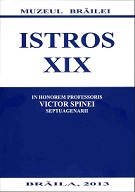Vasele funerare din sticlă. Comerț, contacte interculturale și practici funerare
Glassware for the Dead. Trade, Intercultural Contacts and Mortuary Customs in Late Middle Age Wallachia
Author(s): Marius Păduraru, Dragoş MăndescuSubject(s): History
Published by: EDITURA ISTROS A MUZEULUI BRĂILEI „CAROL I”
Keywords: glass; 15th-17th centuries; funerary customs; trade; Câmpulung.
Summary/Abstract: A series of archaeological discoveries made in the late medieval cemeteries from Wallachia led to the identification of a specific grave good, namely a glass phial, put in the grave on the right side of the deceased. This is obviously an unusual burial practice in the context of Christianity doctrine which prohibits the deposit of offerings in the grave with the dead. The tombs (generally belonging to rich people with high social status) in which it was revealed this type of phial are going from the 15th century until the 17th century. The glass is of a good quality, thin and delicate - undoubtedly a luxury and expensive item. It is certainly an imported product, since the first glass manufacturing of Wallachia was founded not before the mid-17th century. The origin of these small bottles is likely to be found in Transylvania or Central Europe. There has been registered a high density of such kind of bottles in medieval graves in Muscel region, north of the country. The prevalent spreading in this area should be explained through the great trade fair annually held in Câmpulung, the capital city of the region, through which the glass phials were traded.
Journal: ISTROS
- Issue Year: 19/2013
- Issue No: 1
- Page Range: 563-598
- Page Count: 36
- Language: English
- Content File-PDF

